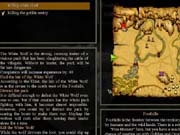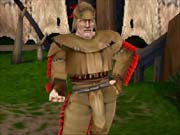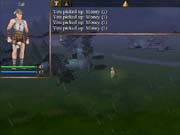For a brand-new game, Nival Interactive's Evil Islands: Curse of the Lost Soul seems awfully familiar. It's by the same Russian development team that did the simple Rage of Mages role-playing games a few years ago, and it has much in common with those games, though Evil Islands sports its own fully 3D engine. The game involves an all-too-familiar tale of a hero who must discover his identity (as in Baldur's Gate, Planescape: Torment, Summoner, and countless others) while slaughtering umpteen monsters in an isometric fantasy setting (as in Diablo, Darkstone, Nox, and countless others). You'll quickly see that originality is not the strong point of Evil Islands. Still, as with many of the games it borrows from, it can be very addicting. Hours will fly past as you progress from one exploit to another, hooked on the hack-and-slash formula that was made popular by Blizzard's hit Diablo. So even though it has a worn-out premise and a host of other shortcomings, somehow these things won't matter much to you when you're cutting down packs of monsters and finding one world-saving thingamabob after another.

The story begins, as it seemingly always does, with a young man waking up with no knowledge of his past. In this case, at least he remembers his name is Zak. Hints of his origins are soon provided by peasants, who greet sleepyhead by proclaiming him to be "the chosen" and then flee in awe. You'll immediately realize that this messiahlike figure is expected to save these helpless citizens from evil. The peasants' village soon becomes the base of operations from which you'll undertake various quests in the land of Gipath. These quests are either assigned to you or hinted at by locals, such as Erfar the Silvertongue, Babur the Tightfist, and Gort the Skullcrusher. The ensuing adventures never amount to much more than errand-boy jobs made dangerous with standard fantasy foes such as orcs, goblins, trolls, and undead, though the goals are mixed up just enough that the proceedings rarely grow stale.
The characters in Evil Islands are somewhat different from those in traditional fantasy RPGs, in that there are no set character classes in the game. Experience points gained from killing foes and completing quests are applied to boost skill in melee, archery, stealing, and in three types of magic skills. With this system, you can choose to build a fighter who's powerful in hand-to-hand combat, an archer who's good at a distance, or a mage who's handy with spells--or a combination of any of these. A wide range of available abilities can likewise be purchased using the experience points you've saved up. A mage might save up for improved skill in lightning magic, while a warrior might use his points on sword mastery. It's a fairly open-ended system.
If there's anything else original about the world of Evil Islands, it's that the initial setting is closer to the Stone Age than the medieval setting that's more common in fantasy-themed games. Characters start off wearing rough leather clothing and wielding stone weapons, and only later progress to more standard fantasy gear like metal swords and armor. This is a little off-putting at first--particularly when you see that Gort the Skullcrusher is decked out in buckskins like some sort of fantasy version of Davy Crockett--though in time you'll come to appreciate the subtle twist that this gives to the typical swords-and-sorcery theme.

What's more disconcerting about the game's characters is the truly horrific voice acting found throughout. Zak basically sounds like a reject from the show Will & Grace. Lines like, "Oh! Are we not frightening!" and "I love magic!" quickly distinguish Zak from other, more masculine fantasy heroes. Other characters in Evil Islands thankfully lack Zak's quirks (though the Gipath villagers do speak in deep Scottish brogues), but they're also ineptly voiced. Most enunciate every word like it's the last they're ever going to speak. This can seriously dampen your enjoyment of the game, as your own party members can often be so obnoxious that you'll want to send them to their doom. On the other hand, you might just as soon appreciation the campiness of the extremely awkward dialogue in the game.
Even if you could ignore the voice acting, the audio in Evil Islands still is nothing to write home about. The musical score is rather repetitive and uses the same bland notes in every battle throughout the game. However, the atmospheric effects found in the game are excellent. The chirping of crickets and the howling of wolves echoing in the night are welcome touches of authenticity that help the game seem a little more believable.
The game's fully 3D engine requires a Direct3D-compatible card and does a good job of handling the action onscreen on a moderate system, even at higher resolutions and at 32-bit color depth. You can shift the camera angle on the fly with just a right click of the mouse and a quick swivel, while zooming in and out is possible with a flick of the mouse wheel. Unfortunately, the quality of the actual graphics in Evil Islands is all over the place. Some of the wilderness terrain looks lifelike, but some of it looks very bland, and most of the characters look poor. At least they animate fairly well, and besides, most of the time you'll fix the perspective far away enough that you won't really notice the ugly details. Focusing in too tightly on Zak and his companions makes it easy to walk right into an enemy, so you're better off keeping the camera pulled back except during pitched battle.

As you progress through Evil Islands, the weaponry you'll find is limited to the typical swords, axes, clubs, and so on, but blueprints can be found during the game that permit the construction of different devices if you've also got the necessary raw materials. There are just 28 spells available, although magic users can alter them with 24 different runes that affect such things as spell potency, range, and targeting. Items can also be infused with spells, so there's no more waiting to pry that magical sword from the cold, dead hands of a monster. Regardless, these customization options aren't as intriguing in Gipath as they are on paper. It's typically easier just to buy weapons than to make them, and magic in the game seems weak compared with a good battle-axe and melee combat skills. At any rate, going through the bother of manufacturing swords and spells makes little sense when you can simply spend a little cash on equally good gear.
Besides this, the basic game engine has some noticeable flaws. Many of your player character's actions require expenditure of stamina points that regenerate only when you're not moving--running draws upon this reserve, as does casting spells (though combat, oddly enough, does not). This simplifies matters greatly for those who just want to enjoy some basic hacking and slashing. Unfortunately, it also forces Zak and his companions to walk, creep, or crawl everywhere they go, slowing Evil Islands to a snail's pace. You could learn another language during all the time you'll spend twiddling your thumbs. While it's true that you can run from point to point, you can only do so with lengthy breaks between sprints to recharge your stamina. And if you play this way, you'll inevitably find your characters winded or unable to cast spells when they stumble upon an enemy.
Battle sequences are a little different from what you might expect. While simple point-and-click combat remains at the core of the game, the designers have livened things up a little. For instance, you can target your foes' limbs in order to reduce their combat proficiencies and to increase your chances of a critical hit. You can also creep up on unsuspecting foes or sneak past them completely. Stealth is often preferable to the direct approach, and Zak must reach a number of goals by sheathing his blade and slinking through the shadows. The only drawback to this approach is how some quests invariably turn into puzzles. For example, even though there may be three or more ways to sneak to a goal, all but one path will find you detected and caught in a deathtrap, up against far more opposition than you can handle. This leads to some trial and error, not to mention a great deal of reloading saved games.
Except for the relative weakness of magic, the combat in Evil Islands is well balanced and becomes suitably tougher as Zak's adventures continue, such that the game stays challenging. The exception to this rule is that all your enemies have the ability to inflict critical hits at random. These deadly strikes come out of the blue and typically do several times as much damage as a normal hit. A critical hit can finish a battle instantly when your characters aren't at full health, which is incredibly frustrating when it happens at the end of a hard-fought scrap you seemed about to win. For what it's worth, your characters can score critical hits, too.

You'll also be frustrated by the lack of good loot to be scavenged from the corpses of vanquished foes. Evil Islands is certainly no Monty Haul campaign. The typical monster doesn't have two gold pieces to rub together, and the items that you'll scrounge for later sale never amount to much cash. Most of the good weapons and armor will be out of reach until you slaughter hundreds of foes. Even worse, while you can rifle an enemy for his meager money pouch, you usually can't grab the powerful club he was just using to beat your brains in, let alone grab his armor.
The game's multiplayer mode supports up to six players via a LAN or the Internet. After a brief character-customization process, players meet up in the village and set off together on various assigned quests. The game is designed to allow for multiple characters to engage in combat at once, but the lack of an integrated online player-matching service in the game means that finding others to adventure with may prove difficult.
Evil Islands: Curse of the Lost Soul is one of those rare games that manages to add up to more than the sum of its parts. Although veteran role-playing gamers will immediately recognize that virtually everything in Evil Islands has been done before in some form--many times before, in fact--they'll still spend untold hours in an eye-glazed stupor with the game, striving to finish just one more quest. Because, for all its flaws, few games manage to resuscitate a tired formula as well as Evil Islands does. While it's true that the designers at Nival Interactive borrowed a lot of elements from games like Blizzard's Diablo, they've also apparently understood that being derivative doesn't have to be a bad thing for an action-packed role-playing game.